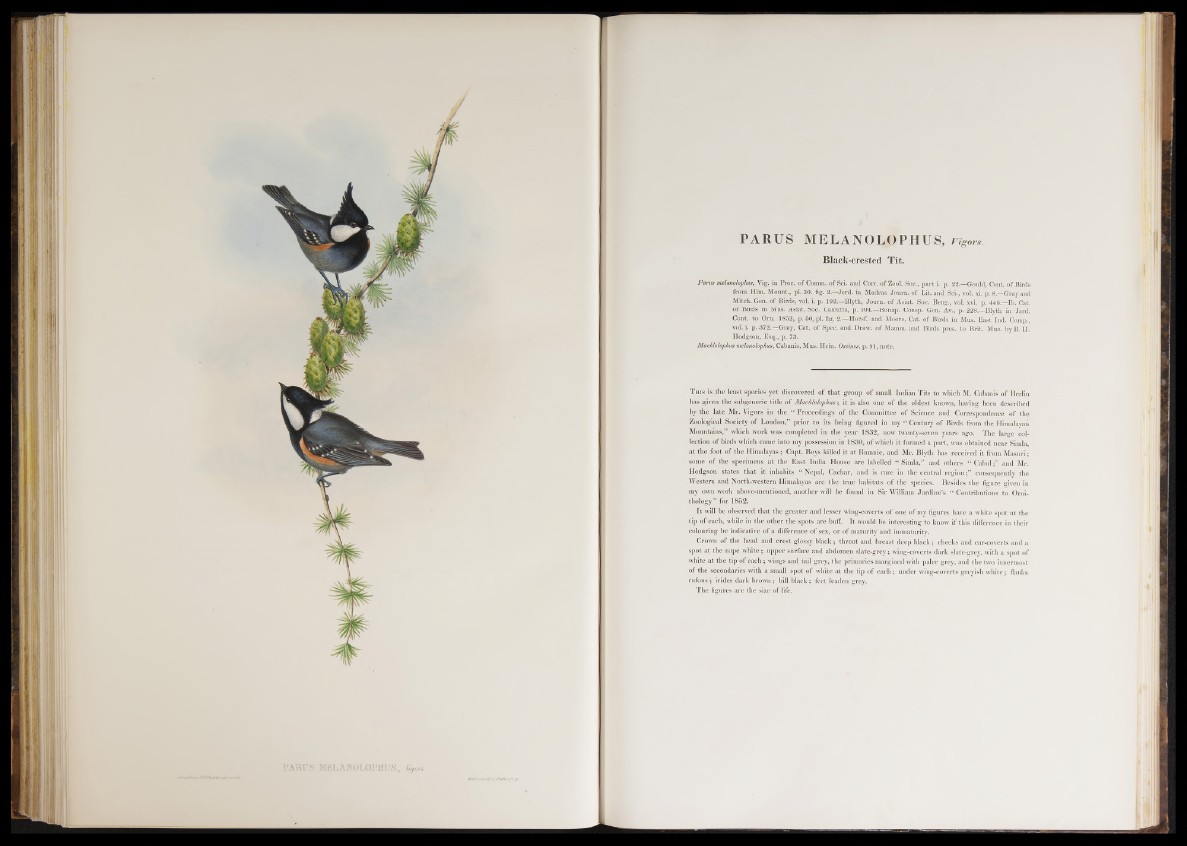
PARUS MELAJTOLOPHUS, %0rs.
P A R U S M E L A N O L O P H U S , Vigors.
Black-crested Tit.
Pams melanolophus, Vig. in Proc. of Comm, of Sci. and Corr. of Zool. Soc., part i. p. 22.—Gould, Cent, of Birds
from Him. Mount., pi. 30. fig. 2.—Jerd. in Madras Journ. of Lit. and Sci., vol. xi. p. 8 —Gray and
Mitch. Gen. of Birds, vol. i. p. 192.—Blyth, Journ. of Asiat. Sog. Beng., vol. xvi. p. 446.—Ib. Cat.
of Birds in Mus. Asiat. Soc. Calcutta, p. 104.—Bonap. Consp. Gen. Av., p. 228.—Blyth in Jard.
Cont. to Om. 1852, p. 50,pi. fig. 2—Horsf. and Moore, Cat. of Birds in Mus. East Ind. Comp.,
vol. i. p. 372..—Gray, Cat. of Spec, and Draw, of Mamm. and Birds pres, to Brit. Mus. by B. H.
Hodgson, Esq., p. 73.
Machlolophus melanolophus, Cabanis, Mus. Hein. Oscines, p. 91, note.
T h is is the least species yet discovered of that group of small Indian Tits to which M. Cabanis of Berlin
has given the suhgeneric title o f Machlolophus; it is also one of the oldest known, having been described
by the late Mr. Vigors in the “ Proceedings of the Committee of Science and Correspondence of the
Zoological Society of London,” prior to its being figured in my “ Century o f Birds from the Himalayan
Mountains,” which work was completed in the year 1832, now twenty-seven years ago. The large collection
o f birds which came into my possession in 1830, of which it formed a part, was obtained near Simla,
at the foot o f the Himalayas; Capt. Boys killed it a t Ramnie, and Mr. Blyth has received it from Masuri;
some of the specimens a t the East India House are labelled “ Simla,” and others “ Cabul;” and Mr.
Hodgson states that it inhabits “ Nepal, Cachar, and is rare in the central region;” consequently the
Western and North-western Himalayas are the true habitats of the species. Besides the figure given in
my own work above-mentioned, another will be found in Sir William Jardine’s “ Contributions to Ornithology
” for 1852.
I t will be observed that the greater and lesser wing-coverts of one o f my figures have a white spot a t the
tip o f each, while in the other the spots are buff. I t would be interesting to know if this difference in their
colouring be indicative o f a difference of sex, or of maturity and immaturity.
Crown of the head and crest glossy black; throat and breast deep black; cheeks and ear-coverts and a
spot a t the nape wh ite; upper surface and abdomen slate-grey; wing-coverts dark slate-grey, with a spot of
white at the tip o f each; wings and tail grey, the primaries margined with paler grey, and the two innermost
of the secondaries with a small spot of white at the tip o f ea ch ; under wing-coverts greyish white; flanks
rufous; irides dark brown; bill black; feet leaden grey.
The figures are the size of life.